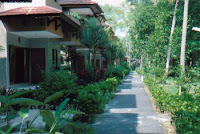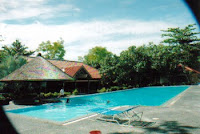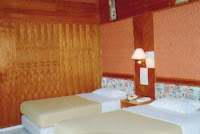UJUNG KULON WILDLIFE
Ujung Kulon has a vast array of wildlfie, quite a number of which are endangered or rare, Some of the animals are so unaffraid that they freely wander in and arround the tourist lodges, others are sighted almost every days, many are heard rather than seen, and some are rarely seen.
Animal
Rhinoceros
The most precious of all the animals in the park is the Javan one horned rhinoceros, the rarest large animal on earth. Once found across much of south east Asia, the first accounts of the Javan rhino date back to China's Tang dynasty (AD 618-906) when Java was noted as a source for rhino horns. In Java during the 1700's rhinos were so numerous and damaging to the agricultural plantations that the government paid a bounty for every rhino killed, bagging five hundred within two years.
Ujung Kulon's rhino population is now estimated at around fifty individuals and they were believed to be the last remaining Javan rhino in the world until a small population was recently discovered in Vietnam. However, these are so few in numbers that their viability is unlikely and so Ujung Kulon remains the last home of this magnificent pachyderm.
In apperance the Javan rhino is closest to the Indian rhino, both having a single horn and skin folds or plates but there are distinct difference between their neck plates and skin textures. The Javan rhino also has a long prehensile upper lip which extends below the lower allowing it to grasp foliage. The body shape of the Javan rhino is designed to push aside the undergrowth and only the male Javan rhino has a prominent horn while the female has a lump similiar to a halved coconut.
Earlier this century Javan rhinos were measured as being over 170 cm at the shoulders, more than 3 metres in lenght and 2,200 kg. in body weight but a recent photographic survey indicates the largest rhino in Ujung Kulon may be around 150 cm in height.
Rhino range over a maximum distance of 15 to 20 kilometers a day in the densely forested lowlands of the Ujung Kulon Peninsula and to the east of its isthmus. They are most mobile at nights, like wallowing in mud pools and sometimes venture onto beaches and grazing grounds.
Although actual sightings of rhinos are rare, their prints dan droppings are often found on the trails, sometime unnervingly fresh. Javan rhinos are believed to be capable of running as fast as a person and so advice to visitors, should they happen to come across one, is to climb the nearest tree and take a photo - in that order.
Deer
Far more obvious animals in the park are the Javan rusa deer that freely graze around the tourist lodges. These are the largest of the three deer species in Ujung Kulon. The rusa stags are at their most magnificent in the mating season aroung August to September when the antlers have shed their velvet and territorial battles between the stags begin.
The smaller Barking deer has along, sleek head and measures aroung 60-70 cm. at the shoulders. The stags have short, two pointed antlers and tusk-like canine teeth. Their favourite habitat is the outer edges of the forest where vegetation is low to the ground and when fleeing their white under tail catches the eye.
The smallest is the Mouse deer which measures only 20-25 cm. in height and has a reddish brown coat with white underparts. The stag does not have antlers but instead has long curving canine teeth that extend outside the mouth. In the early years visitors to Ujung Kulon witnessed a Mouse deer ripping open the stomach of a rival during a matting fight. Their habitat is within the forest and they rarely venture onto beaches and clearings.
Banteng
Since pre historic time these wild cattle have lived throughout Java and in the 17th century were usedto carry loads but now the herd roam wild and are found in just a few locations throughout the island. The males have black coats while the female are usually a golden brown and both have white buttocks and stockings. A mature bull can measure over 170 cm. at the shoulders and although both sexes have horns, only the males are large and curved. Banteng favour open grassy clearings for grazing particularly early and late in the day but also feed on the forest's young secondary growth and are found throughout the Peninsula and southern Gunung Honje regions.
Primate
Ujung Kulon has five species of primates with the brown, long-tailed, Crab eating macaques being the most commonly seen especially on beaches and reefs at low tide. Peucang Island supports four separate group numbering over two hundred individuals.
Wild Pigs
Ujung Kulon has two types of wild pig, the Eurasian wild pig and the Javan warty pig. Similiar in size and weight. the Eurasian wild pig sometimes has a light greyish white stripe from the head to the chest while the male Javan warty prig hast three pairs of lumps or warts on the face which can give an old male a montrous appearance. The coat of the young Eurasian piglet has long yellowish-brown stripes and when disturbed they often make short loud grunts while warty pigs have a high pitched cry. Wild pig are surprisingly good swimmers and have been known to cross the 700 meters channel between the Peninsula and Peucang Island
Cats
The cat family was represented by five species although the last positive sighting of a Javan tiger in Ujung Kulon was in the 1950's and it is believed that they are now part of the long list of the world's extinct animals. However, leopards measuring over half a metre at the shoulder and over 1,5 meters in lenght, number as many as sixty in Ujung Kulon and their tracks are sometimes seen on beaches and stream beds. The black rosettes on their coat have background colors that can vary from a light strawyellow to orange-yellow and it is not uncommon for the leopards to have completely black coats.
Fishing cats, named for their ability to scoop fish out of water, are considerably smaller than leopards but larger than domestic and the jungle or leopard cats, which tend to frequent the boundary regions of the park near settlements.
Civest
Between a fox and ferret in size with short legs, long muzzle and a tail the same lenght as its body, the most often seen of these predators is the common palm civet which is found throughout the park including Panaitan island.
Wild Dogs
These are quite different from their domesticcated village dogs seen throughout Indonesia as they are smaller, squatter, have a red-brown coat a fox like appearance. They live and hunt in packs and in 1846 there was an account of hundreds of large turtles, some of which were well over a meter in lenght, being over turned and killed by a dog pack on Ujung Kulon's south coast. Then unaccountably their numbers decreased to the point where they were never seen in Ujung Kulon until earlier this century when they again re-appeared possibly partly due to the dwindling tiger population.
Squirrels
Of the thirteen species species of squirrels in Java the two most often seen in the park are the Malay giant squirrel and the Common Malay or Coconut squirrles. The giant squirrels has a shiny black, reddish, cream and fawn coat and its favourites habitat is amongst the tall trees. At the sightest suspicion of danger they make a loudrattling call accompanied by jerking movements with their long lush tails. The small and very mobile coconut squirrel is medium brown in color, make a loud cackling noise and although it can sometimes be found on the forest floor it usually is seen scampering up trunks or exploring branches.
Lemur
The remarkable Malay flying lemur does not actually fly but glides through the forest canopy with the aid of a membrane that stretches from the neck to the tips of its body. When air borne this membrane becomes kite-like and allows the lemur to travel for distance of 70 meters.
Bats
Of the seventy or more types of bats found in Java, the two most often seen in Ujung Kulon are the large flying fox and the Horsfield's roundleaf bat. Flying foxes hang in groups high up in large trees during the day and leisurely wing their way across the early morning and late afternoon skies, often being mistaken for large birds. The small Horsefield bats however, spend their days in caves often shared with nesting swftlets. Asmall colony of these bats are found at Karang Copong on Peucang Island.
Birds
Although over 250 species have been recorded in Ujung Kulon the birds are not always easily seen as many live high in the forest canopy or are vigilant inhabitants of the dense undergrowth. However it is the constant bird calls of Ujung Kulon that contribute to the atmosphere of the forest, for seldom is the park silent.
The most conspicuous of the birds are the hornbills as the park resounds with their wing beats and raucous calls, Of the three species in the park, the biggest is the black and white Rhinoceros hornbill with a broad black band across its white tail, a large upward curving orange-red casque above the bill and makes a loud, harsh ' kronnk'. The Asian pied hornbill, of the same coloring, has white tipped wings and a yellow and white casque. It is the smallest and the noisiest making incessant 'yak yak' calls. Normally found in pairs, the hornbills nesting habits are especially interesting. At the begining of the nesting period, the male hornbill cements the female and continues until the young are half grown. The female then breaks out and the nest entrance is re sealed until the young decide to leave.
The largest eagle in the park, the white bellied sea eagle has a wedge shaped tail and is often seen soaring along the shores preying on fish and sea snakes. The smaller crested serpent-eagle withish tail bars and wing bands is frequently seen in pairs wheeling in circles over the forest in search of snakes.
The green peafowl often referred to as a peacock regardless of sex, frequents the grazing ground and clearings, Java has the world;s largest wild population of these magnificent birds and a great proportion are found in Ujung Kulon.
Ujung Kulon National Park
Introduction | The Land | Plant Life | Wild Life | Marine Life | The People | Attractions | Map Ujung Kulon


















